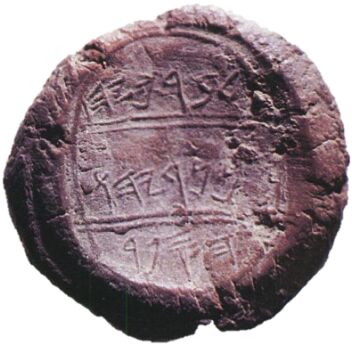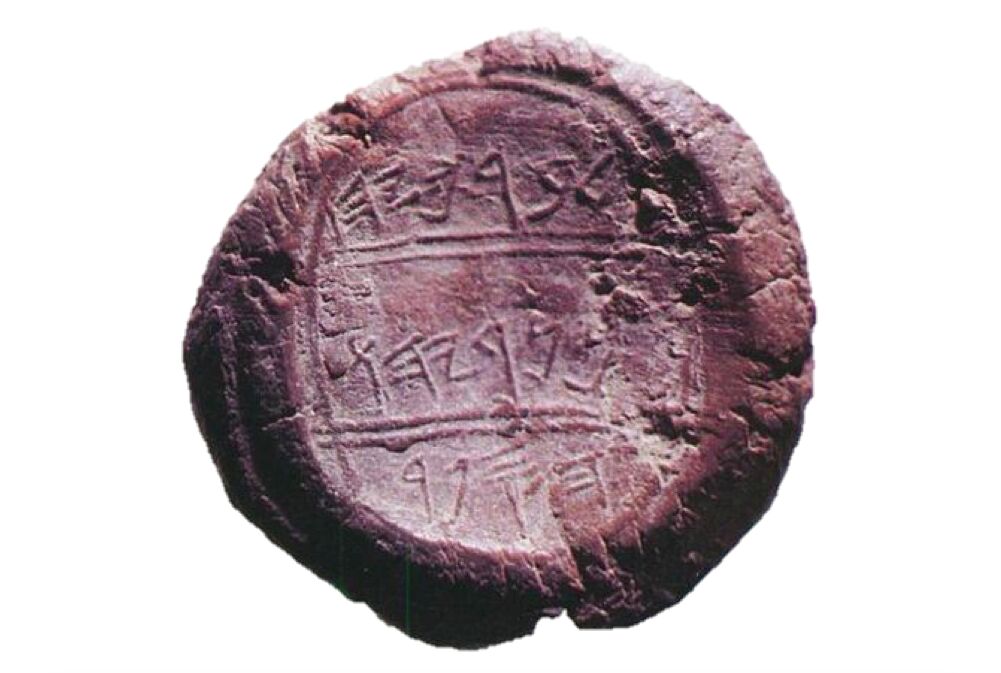During the 1970s, two bullae (clay seal stamps) turned up on the antiquities market. These items had an identical impression, made by the same seal stamp. They read: “Belonging to Berechiahu, son of Neriahu, the Scribe.” Or in its simplified biblical name form: Baruch, son of Neriah. Notice Jeremiah 36:32:
Then took Jeremiah another roll, and gave it to Baruch the scribe, the son of Neriah; who wrote therein from the mouth of Jeremiah ….

The bullae, owned and displayed by the Israel Museum and famous collector Shlomo Moussaieff, represented exciting inscriptional proof for the famous biblical prophet’s right-hand man, through whom the book of Jeremiah was written.
Or did it? There was one, rather big, problem: how they were acquired.
The “antiquities market” is a place where artifacts of unknown provenance are bought and sold. A superb amount of beautiful inscriptions, coins, stamps, etc have been acquired in this manner. The problem is, without them having been unearthed and documented in scientific excavation, it can be particularly tricky to determine legitimate artifacts from forged ones. These are items that have been pulled from the ground, metal-detected, stolen from dig sites, etc.—legitimate artifacts—or else they are carefully crafted forgeries. As such, with many of these items, there is a degree of doubt that hangs over them. Still, some of the world’s most fabulous, proved-genuine artifacts have come from the antiquities market (such as Sennacherib’s prisms).

The Baruch bullae represent just two of many hundreds of bullae sold on the antiquities market. For example, a number of bullae belonging to King Hezekiah were found on the antiquities market, but because of their unknown provenance, their authenticity could only be classed as “likely.” That is, until the discovery of an identical bulla belonging to the king during Dr. Eilat Mazar’s 2009–10 Ophel excavation, which proved them to be genuine.
The Baruch bullae, however, have not been so fortunate. These items were concluded to be modern forgeries, based on a series of analyses and subsequent papers over the course of the last two decades. Chief evidence provided was the following (particularly addressed in the 2014 article “The Authenticity of the Bullae of Berekhyahu Son of Neriyahu the Scribe,” by Prof. Yuval Goren and Dr. Eran Arie, and the 2016 article “The Bullae of Baruch ben Neriah the Scribe and the Seal of Ma’adanah Daughter of the King: Epigraphic Forgeries of the 20th Century,” by Prof. Christopher Rollston):
- The rear side of the bullae had an unusual grain, not the typical papyrus—perhaps that of a corn plant.
- The rear side showed a cord imprint that was thicker and coarser than typical for tying together documents.
- The rear side showed that the bullae were pressed over the binding cord, rather than the cord knot.
- The clay is of the Moza marl variety, not terra rosa soil used exclusively by Jerusalem scribes.
- The spelling of “the scribe” was of four letters, rather than the expected five (hspr, instead of hswpr).
- The general size and positioning of the “s” in “scribe” is slightly off, in comparison to the following letter (“p”)—perhaps an example of a forger looking at a simple letter chart.
- The bullae were found to be covered in a glue-like chemical preservation substance.
- The fact that the clay wasn’t fired means that in the case of a natural patina developing, it would have caused such an unprotected ancient object to crumble and fall apart long ago.
The evidence was condemning, and the Baruch bullae were classified as “forgeries.”
Not So Fast
But that has not been the end of the matter. In 2016, an academic response to the claims of Goren, Arie and Rollston was published by Dr. Pieter Gert van der Veen, Dr. Gabriel Barkay and Robert Deustch, in an article titled “Reconsidering the Authenticity of the Berekhyahu Bullae: A Rejoinder.” Deutsch, Barkay and Gert van der Veen do not claim that their reappraisal confirms the authenticity of the Baruch bullae, but what they do show is that none of the earlier research disproves it—quite to the contrary.
The following is a summary of their conclusions—numbered below, corresponding to the above-numbered allegations.
- Reanalysis shows a wood grain on the rear side of the bulla. While papyrus is a common medium, a large percentage of excavated bullae show imprints of a variety of different mediums, including wood (such bullae have been unearthed specifically in Jerusalem). These bullae could have been pressed onto any kind of wooden box or item, but perhaps specifically ancient wooden writing boards. There is a precedent for this—Neo-Assyrian bullae have been discovered, that were apparently used to seal such items. (And writing boards would certainly have fit with Baruch’s role as scribe.) Further, hinges for such ancient writing boards, dating to the relevant period, have been discovered in Jerusalem.
- There are a variety of different cord types imprinted on the rear of seals—not just finely woven cord for sealing papyrus. A thicker, coarser cord would have been more suited to binding a heavier wooden object. Further, the angle of the string imprints on the Baruch bullae run at a diagonal to the wood grain—this matches the above-mentioned parallel Neo-Assyrian “writing board” bullae, whose string lines run diagonally to the wood grain.
- Bullae were not only pressed over and “locking” the cord knot—they were also affixed to the simple cord string. This is particularly applicable when several bullae are used to seal a single document.
- The authors have called into question the validity of identifying the bullae clay as Moza marl—based on prior problems and critiques leveled against Goren’s team regarding clay identification. Still, while the regional terra rosa clay was typically used for bullae in Jerusalem, at least one provenanced example does exist of a Jerusalem bulla made of Moza clay. Still, the Baruch bullae were unprovenanced, and may not have even been made in Jerusalem.
- The title “the scribe” indeed uses only four letters—hspr—instead of the expected (and biblical) example of five (hswpr). But the authors highlight the common nature of inconsistent and cropped words on small bullae. Furthermore, there are no provenanced Judahite bullae bearing the title “the scribe.” There are, however, parallel examples of this title—spelled the same way (hspr)—from non-Judahite locations (including a provenanced Phoenician seal). And there are several unprovenanced examples of this spelling, appearing on the antiquities market as far back as the 1800s (when such paleography was not well known).
- The argument about the small shape and proportion of the “s” in “scribe” was made by Rollston based on comparisons with a number of other inscriptions, including ostraca—but only using one seal as an example. The typically bigger “s” can easily fit on larger inscriptions, but is more difficult to include on a miniature seal. His example seal dates several centuries earlier than the Baruch bullae (if they are indeed genuine). And representative examples do exist of “s” bullae letters—provenanced and unprovenanced—shaped similarly to those on the Baruch bullae.
- A glue-like preserving substance was indeed found on the bullae—but this was a typical preservation technique used several decades ago. It constituted a cleaning, application with a chemical solution (Pearloid), and finally, a fine white powder dusting used to help the letters stand out. The former owner of one of the Baruch bullae, Rafi Brown (himself a former professional conservator), testified before a forgery court as to this early preservation process. And the authors further draw attention to the lack of evidence for modern contamination within the clay of the bulla itself.
- Regarding patina remains on the bullae: it is clear that they were not hardened by a firing/destruction event. Goren’s team argued that the present patina would have caused an authentic unfired bulla to crumble. But this is not necessarily the case—the authors point to the discovery of several unfired bullae, provenanced and unprovenanced, that have survived even in unprotected conditions (i.e. that were not sealed in jars).
- A final, additional point made by the authors: the fingerprints that mark the edges of the Baruch bullae. They suggest that expert fakers would not tend to leave potentially incriminating fingerprints on their work.
With their article, Barkay, Deutsch and Gert van der Veen dismiss the evidence held up as “proof” that the Baruch bullae are forgeries. Of course, the two bullae remain unprovenanced and are at present virtually impossible to prove 100 percent (without the excavation of a parallel example). But the authors do point out the odds of the bullae being forged, particularly considering the exact ancient parallels of binding and pressing on wooden tablets: “The Berekhyahu Bullae seem to comply with this evidence so well that its very recognition by a potential forger would have demanded in-depth knowledge of fixation methods to wooden writing boards, information that only became more readily available after 1992”—decades after the bullae were purchased.
The present evidence does not incriminate the Baruch bullae. In fact, the extant information goes toward the support of their legitimacy. Of course, the reader can make up his or her own mind.
But again, such is the frustrating problem with the antiquities market: A fascinating trove of many (if not mostly?) legitimate items—but because they are taken out of any original context, there remains a lingering element of doubt. Still, that doubt can be challenged by how well the bullae fit proven parameters—and especially if those parameters were not scientifically known at the time the bullae came to light.
Thus, taking into account the above considerations: Alongside the genuine, provenanced bullae of Jeremiah’s contemporaries Gedaliah son of Pashur (Jeremiah 38:1), Jehucal son of Shelemiah (Jeremiah 37:3), and Gemariah son of Shaphan (Jeremiah 36:10), do we now have evidence of the prophet’s most famous right-hand man, Baruch, son of Neriah, the Scribe?


